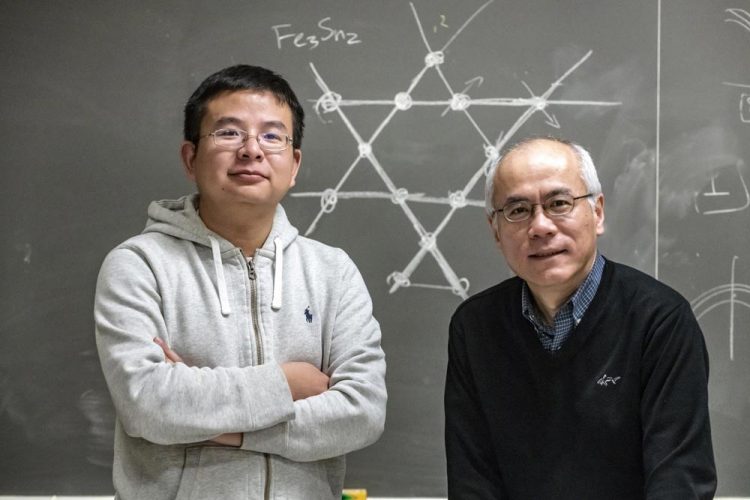A new 'spin' on kagome lattices

Boston College researcher Kun Jiang, PhD, and Professor of Physics Ziqiang Wang. The theoretical physicists have been studying novel quantum electronic states resulting from the interplay of electron-electron interaction, geometrical frustration, and topological band structures. Credit: Lee Pellegrini/Boston College
Like so many targets of scientific inquiry, the class of material referred to as the kagome magnet has proven to be a source of both frustration and amazement. Further revealing the quantum properties of the kagome magnet is seen as one of the primary challenges in fundamental physics – to both theorists and experimentalists.
An unusual underlying geometry of the atomic arrangement is central to the value of these materials. Kagome lattices are described as intersecting webs of “corner-sharing triangles” and are prized for the unique behavior of the traversing electrons, fertile ground for the study of quantum electronic states described as frustrated, correlated and topological.
A recent study by an international group of researchers, published in the journal Nature, found the kagome ferromagnet Fe3Sn2 exhibits an electronic state that couples unusually strongly to an applied magnetic field that can be rotated to point in any direction of a 3-dimensional space, revealing in quantum scale a “giant” magnetization-driven electronic energy shift taking place within the material.
That energy shift sheds new light on the presence of spin-orbit coupling and topological spin textures in kagome lattices, where magnetic and electronic structures are entangled and produce unusual – often previously unknown – spin-orbit activity, said Boston College Professor of Physics Ziqiang Wang, a co-author of the report, titled “Giant and anisotropic spin-orbit tunability in a strongly correlated kagome magnet.”
“We found out two things. The first one is that the electronic state of Fe3Sn2 is nematic, a state that spontaneously breaks the rotation symmetry. The electrons behave as a liquid crystal inside this magnet, presumably due to the strong electron-electron interaction,” said Wang. “The second thing we found is you can manipulate and make big changes to the electron energy structure through tuning the magnetic structure by applying a magnetic field.”
Wang, a theoretical physicist, and graduate student Kun Jiang, PhD, who have been studying novel quantum electronic states resulting from the interplay of electron-electron interaction, geometrical frustration, and topological band structures, joined experimentalist colleagues who first noted the unusual electronic activity as they studied the material using scanning tunneling microscopy.
The team – which included researchers from BC, Princeton University, Chinese Academy of Sciences, Renmin University, and Peking University – used STM and vector-magnetic-field tools to identify the spin-orbit coupled electronic properties of the kagome ferromagnet and explored the exotic phenomena within it, while performing modeling and calculations to provide theoretical interpretation and understanding of the observed phenomena.
“What our colleagues found is that by changing the direction of the magnetic field, they saw changes in the electronic states that are anomalously large,” said Wang. “The shifts of the bands – there are band gaps, forbidden regions in quantum mechanics where electrons cannot reside – those regions can be tuned enormously by the applied magnetic field.”
The “band shift” is a change in electronic band structure, said Wang. It expands and narrows the band gap depending on the magnetic field directions. The kagome ferromagnet showed a shift approximately 150 times larger than ordinary materials.
Probing the interference patterns of the electron's quantum mechanical wave functions revealed consistent spontaneous nematicity — an indication of important electron correlation that causes the rotation symmetry-breaking of the electronic state in the material.
These spin-driven giant electronic responses indicated the possibility of an underlying correlated magnetic topological phase, the researchers reported.
The tunability of the kagome magnet revealed a strong interplay between an externally applied magnetic field and nematicity, providing new ways of controlling spin-orbit properties and exploring emergent phenomena in topological or quantum materials, the team wrote.
The giant magnetic field tunability of the electrical properties may one day lead to potential applications in electronic devices such as memory and information storage and sensing technologies, said Wang.
“What's exciting in these results is the potential of realizing something useful,” said Wang. “This is coming from very fundamental physics, but it may one day connect to applications. We don't understand everything, but we now know this is a material that contains all these important ingredients.”
Media Contact
More Information:
http://dx.doi.org/10.1038/s41586-018-0502-7All latest news from the category: Physics and Astronomy
This area deals with the fundamental laws and building blocks of nature and how they interact, the properties and the behavior of matter, and research into space and time and their structures.
innovations-report provides in-depth reports and articles on subjects such as astrophysics, laser technologies, nuclear, quantum, particle and solid-state physics, nanotechnologies, planetary research and findings (Mars, Venus) and developments related to the Hubble Telescope.
Newest articles

NASA: Mystery of life’s handedness deepens
The mystery of why life uses molecules with specific orientations has deepened with a NASA-funded discovery that RNA — a key molecule thought to have potentially held the instructions for…

What are the effects of historic lithium mining on water quality?
Study reveals low levels of common contaminants but high levels of other elements in waters associated with an abandoned lithium mine. Lithium ore and mining waste from a historic lithium…

Quantum-inspired design boosts efficiency of heat-to-electricity conversion
Rice engineers take unconventional route to improving thermophotovoltaic systems. Researchers at Rice University have found a new way to improve a key element of thermophotovoltaic (TPV) systems, which convert heat…



